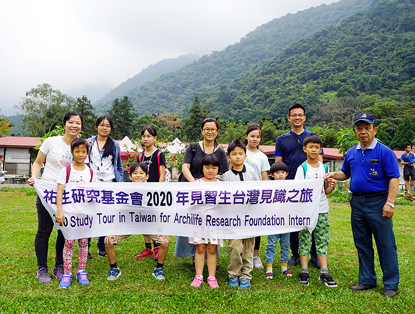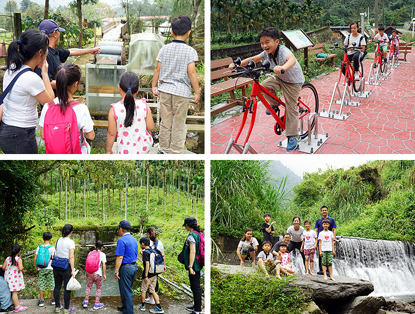Sketch of Archilife Study Tour, October 2020Date: 2020-11-18
Section: Activity |  10月份見識之旅活動,於2020年10月17日由呂明澐小姐帶領9位祐生見習生及家長們,進行魚池東光社區走訪暨農村綠能探索之旅。活動開始之初,領隊呂明澐小姐提醒本次活動注意事項及觀察重點,先行建立見習生的背景知識。 10月份見識之旅活動,於2020年10月17日由呂明澐小姐帶領9位祐生見習生及家長們,進行魚池東光社區走訪暨農村綠能探索之旅。活動開始之初,領隊呂明澐小姐提醒本次活動注意事項及觀察重點,先行建立見習生的背景知識。
For the study tour of October 17, 2020, Ms. Lu Ming-yun led 9 ARF interns and their parents on a rural green energy exploration tour to the Tungkuang community in Yuchih Township. At the start of the day's activities, team leader Ms. Lu Ming-yun reminded everyone about things to note and what to observe, and gave the interns some background knowledge.
 本次行程以參訪南投東光社區為主軸,由社區發展協會總幹事蔡鴻銘先生擔任導覽老師。行程第一站至翠林農場,導覽老師首先說明我們所在之處屬台灣地理位置的中心點,年均溫為19.3度,是氣候宜人適合居住的好地方。接著眾人將目光聚焦於一旁的簡易發電水車,東光社區是水源保育社區示範區,為實踐水源永續概念,農場主人運用五金與廢棄腳踏車輪組裝,引木屐囒溪的水源及太陽能作為能源,發電量可供農場內一盞路燈使用。隨後前往微水力發電綠能區,導覽老師介紹此設施以向天圳穩定的水量作為發電基礎,目前仍在測試運轉中,未來將用於社區公共用電。向天圳是武界引水隧道為跨越木屐囒溪所設的水橋,其水源引自發源於合歡山的濁水溪,該處集水區土石鬆軟,泥沙容易被溪水沖刷,因此含沙量特別高,故渠道中的水較為混濁。而水橋下方溪谷水質清澈,眾人在導覽老師帶領下前往進行溪遊活動。 本次行程以參訪南投東光社區為主軸,由社區發展協會總幹事蔡鴻銘先生擔任導覽老師。行程第一站至翠林農場,導覽老師首先說明我們所在之處屬台灣地理位置的中心點,年均溫為19.3度,是氣候宜人適合居住的好地方。接著眾人將目光聚焦於一旁的簡易發電水車,東光社區是水源保育社區示範區,為實踐水源永續概念,農場主人運用五金與廢棄腳踏車輪組裝,引木屐囒溪的水源及太陽能作為能源,發電量可供農場內一盞路燈使用。隨後前往微水力發電綠能區,導覽老師介紹此設施以向天圳穩定的水量作為發電基礎,目前仍在測試運轉中,未來將用於社區公共用電。向天圳是武界引水隧道為跨越木屐囒溪所設的水橋,其水源引自發源於合歡山的濁水溪,該處集水區土石鬆軟,泥沙容易被溪水沖刷,因此含沙量特別高,故渠道中的水較為混濁。而水橋下方溪谷水質清澈,眾人在導覽老師帶領下前往進行溪遊活動。
This tour featured a visit to the Tungkuang community in Nantou, with Mr. Tsai Hung-ming, Executive Secretary of the Community Development Association, acting as a tour guide. The first stop on the itinerary was at Cuilin Farm, where Mr. Tsai explained that we were located in the center of the island, with an average annual temperature of 19.3 degrees Celsius, making it a pleasant place to live. Then we turned our attention to a simple water wheel for power generation on the side. The Tungkuang community is a demonstration area for water conservation. To put water sustainability into practice, the owner of the farm assembled hardware and discarded bicycle wheels to draw water from the Muchilan River and solar energy as a source of power, generating enough electricity for a single street light at the farm. Afterwards, we went to a micro-hydropower green energy generation area where Mr. Tsai introduced a facility that uses the stable water volume of the Hsiang Tien Canal as a basis for power generation, and that is still on trial run and is slated for public electricity consumption in the community. Hsiang Tien Canal is a water bridge set up by a headrace tunnel in the village of Wujie to cross the Muchilan River. Its water is drawn from the Zhuoshui River that originates from the Hehuan Mountain. The soil and stone in the catchment area are soft and the sediment is susceptible to being washed by the stream, so the sand content is particularly high and the water in the channel is therefore rather turbid. The water in the valley below the bridge was crystal clear and the group was taken on a guided tour of the river.
 下午進行社區導覽,首先步行至導覽老師本家的蔡家古宅,原為七開間大宅三合院,檐廊木架雕工細緻、色樣古樸,921大地震後,僅存正堂與右護龍,二者皆有損壞,除正堂屋瓦移位略有整修外,右護龍嚴重損毀,蔡家子孫雖有心保存,卻無力承擔修復費用。接著來到社區裡的蝴蝶廊道,導覽老師利用自宅周邊的土地栽種蜜源植物,打造一條近百公尺長的蝴蝶生態廊道,吸引紫斑蝶、青斑蝶、樺斑蝶覓食,此外,蝴蝶園區內設置流籠,提供見習生搭乘體驗。行程最後進行後大埔石櫟鑰匙圈DIY,導覽老師介紹後大埔石櫟,其樣貌似老式煙斗頭,故又稱煙斗石櫟,果核十分堅硬,若要食用則須先拿鐵鎚敲開,因考量成本問題而未量產上市,隨即以鐵鎚敲碎果核,讓眾人品嚐其真實滋味。至此,本日活動已近尾聲,大家一起合照留念後搭車返程,並期待於下次見識之旅再相見。 下午進行社區導覽,首先步行至導覽老師本家的蔡家古宅,原為七開間大宅三合院,檐廊木架雕工細緻、色樣古樸,921大地震後,僅存正堂與右護龍,二者皆有損壞,除正堂屋瓦移位略有整修外,右護龍嚴重損毀,蔡家子孫雖有心保存,卻無力承擔修復費用。接著來到社區裡的蝴蝶廊道,導覽老師利用自宅周邊的土地栽種蜜源植物,打造一條近百公尺長的蝴蝶生態廊道,吸引紫斑蝶、青斑蝶、樺斑蝶覓食,此外,蝴蝶園區內設置流籠,提供見習生搭乘體驗。行程最後進行後大埔石櫟鑰匙圈DIY,導覽老師介紹後大埔石櫟,其樣貌似老式煙斗頭,故又稱煙斗石櫟,果核十分堅硬,若要食用則須先拿鐵鎚敲開,因考量成本問題而未量產上市,隨即以鐵鎚敲碎果核,讓眾人品嚐其真實滋味。至此,本日活動已近尾聲,大家一起合照留念後搭車返程,並期待於下次見識之旅再相見。
In the afternoon, we set out on a visit to a community by going on foot to the old house of the Tsai family, which was originally a sanheyuan with seven kaijian in width, with an intricately carved wooden veranda set in an ancient style. Only the main hall and the right wing survived the ravages of the 921 earthquake, but both of which were damaged. While the roof tiles of the main hall that had been displaced were slightly repaired, the right wing was severely ruined, and the Tsai family could not afford the cost of restoration, despite their desire to preserve it. And then we moved on to the community's butterfly corridor, where Mr. Tsai used the land around his house to grow nectar plants, thereby creating a butterfly ecological corridor nearly 100 meters long, attracting purple crow butterflies, blue tiger butterflies and plain tiger butterflies to forage for food. In addition, the butterfly area is equipped with a cable car for interns to have a ride. At the end of the trip, we had a DIY session on a key ring made of How-dah-pu Tanoak(Lithocarpus corneus), and Mr. Tsai introduced How-dah-pu Tanoak, which looks like an old-fashioned pipe bowl, so it is also known as Pipe Lithocarpus, the core of which is so hard that if you want to eat it, you have to take a hammer to crack it open first, and due to cost factors, it is not produced in large quantities. Then Mr. Tsai cracked the kernel with a hammer for everyone to have a taste of it. At this point, the day's itinerary came to an end. Everyone took a group photo before heading back and looked forward to the next study tour.
|
|